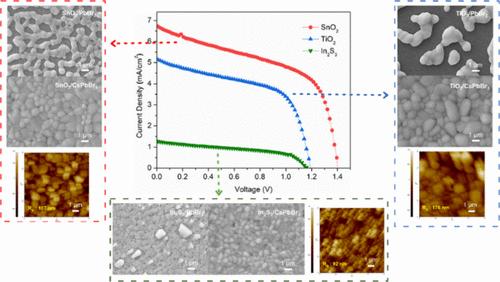Crystallization Behavior of Ambient-Air-Processed CsPbBr3 Thin Films on Various Electron Transport Layers and Its Impact on Solar Cell Performance
IF 3.2
3区 化学
Q2 CHEMISTRY, PHYSICAL
引用次数: 0
Abstract
CsPbBr3 perovskite is a promising wide-bandgap semiconductor for photovoltaic applications, but its crystallization dynamics and charge transport properties are highly dependent on interfacial interactions with electron transport layers (ETLs). This study systematically investigates the influence of ETLs: SnO2, TiO2, and In2S3, on the crystallization, morphology, and photovoltaic performance of CsPbBr3 thin films processed under ambient-air conditions. The choice of ETL is found to significantly affect the structural evolution of the PbBr2 precursor and the final CsPbBr3 film, impacting the device efficiency. Among the studied ETLs, SnO2 promotes the formation of compact and uniform CsPbBr3 films, leading to the highest power conversion efficiency (PCE) of 5.05%. In comparison, TiO2-based devices exhibit a moderate efficiency of 3.44% due to suboptimal film flatness, whereas In2S3 results in small-grained films with high defect densities, limiting the efficiency to 0.70%. Photoluminescence and impedance spectroscopy analyses further confirm that SnO2 effectively suppresses defect-mediated recombination, enhancing charge transport and extraction. These findings underscore the crucial role of ETL selection in optimizing CsPbBr3 crystallization and provide valuable insights for developing efficient wide-bandgap perovskite solar cells under ambient conditions.

环境空气处理CsPbBr3薄膜在不同电子传输层上的结晶行为及其对太阳能电池性能的影响
CsPbBr3钙钛矿是一种很有前途的宽带隙光伏半导体,但其结晶动力学和电荷输运性能高度依赖于与电子输运层(etl)的界面相互作用。本研究系统地研究了ETLs: SnO2、TiO2和In2S3对环境空气条件下CsPbBr3薄膜的结晶、形貌和光伏性能的影响。发现ETL的选择显著影响PbBr2前驱体和最终CsPbBr3薄膜的结构演变,影响器件效率。在所研究的etl中,SnO2促进CsPbBr3薄膜形成致密均匀,功率转换效率(PCE)最高,达到5.05%。相比之下,由于薄膜平整度不够理想,tio2基器件的效率为3.44%,而In2S3基器件的缺陷密度小,导致效率限制在0.70%。光致发光和阻抗谱分析进一步证实,SnO2有效抑制缺陷介导的重组,增强电荷输运和萃取。这些发现强调了ETL选择在优化CsPbBr3结晶中的关键作用,并为在环境条件下开发高效的宽禁带钙钛矿太阳能电池提供了有价值的见解。
本文章由计算机程序翻译,如有差异,请以英文原文为准。
求助全文
约1分钟内获得全文
求助全文
来源期刊

The Journal of Physical Chemistry C
化学-材料科学:综合
CiteScore
6.50
自引率
8.10%
发文量
2047
审稿时长
1.8 months
期刊介绍:
The Journal of Physical Chemistry A/B/C is devoted to reporting new and original experimental and theoretical basic research of interest to physical chemists, biophysical chemists, and chemical physicists.
 求助内容:
求助内容: 应助结果提醒方式:
应助结果提醒方式:


